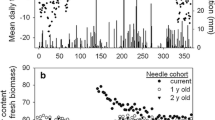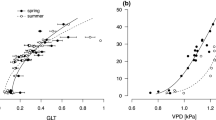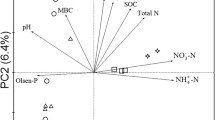Summary
Microclimate and photosynthesis of krummholz mat growth forms of Picea engelmanii (Parry) and Abies lasiocarpa [Hook.] Nutt. were investigated to determine structural features which may aid survival in alpine environments. The structure of krummholz mats was described in terms of the vertical distribution of leaf area index and leaf area density, which exceeded 50 m-1 (based on total leaf surface area) near the canopy surface and approached zero below 30 cm from the surface in both species. Photosynthetic photon flux density (PPFD, 0.4–0.7 μm wavelengths) and wind decreased by an average of 6 and 50-fold, respectively, between 1 m above and 10 cm below mat surfaces in both species. Needle temperatures on a P. engelmannii krummholz mat during July averaged about 2°C above air temperature during the day, with a maximum overtemperature of greater than 20°C above T air during one sunlit period. At night, needle temperatures averaged 3–4°C below T air.
Net photosynthesis in year-old P. engelmannii shoots reached a maximum at 15–20°C during July and August. Surface shoots were light saturated at near 1200 μmoles m-2s-1 PPFD, and had higher photosynthetic rates than subsurface, predominantly shaded shoots above 800 μmoles m-2s-1. Shade shoots had higher photosynthetic rates when PPFD was below 600 μmoles m-2s-1, and at 250 μmoles m-2s-1 shade shoots maintained about 50% of the net photosynthetic rate of sun shoots at light saturation. Shade shoots appeared capable of benefitting photosynthetically from elevated temperatures within krummholz mats despite relatively low light levels. Especially rapid photosynthesis may occur when canopy needles are illuminated by sunflecks and needle temperatures rise by 10° C or more.
Snow cover appears crucial for the survival of needles during winter. Snow accumulated within krummholz needle canopies before the sub-canopy zone of unfoliated branches became filled. The concentrated needle growth in the krummholz canopy captured snow in early autumn without support from ground-level snowpack. Early snow cover in both species prevented cuticle abrasion and resulted in high winter needle water contents and viabilities for subsurface compared to surface needles which became abraded, severely dehydrated, and had high mortality between December and February, especially on windward sides of shoots.
Extremely high concentrations of needles within krummholz mat canopies created an aerodynamic structure which elevated needle temperatures to more optimal photosynthetic levels in summer and resulted in more efficient snow accumulation in winter. These factors appear crucial for winter needle survival. Thus, krummholz mats appear to be an important adaptation in growth form which provides survival benefits in both summer and winter.
Similar content being viewed by others
References
Becwar MJ, Rajashekar C, Hansen-Bristow KJ, Burke MJ (1981) Deep undercooling of tissue water and winter hardiness limitations in timberline flora. Plant Physiol 68:111–114
Bergen JD (1971) Vertical profiles of windspeed in a pine stand. Forest Sci 17:314–321
Billings WD (1969) Vegetational pattern near alpine timberline as affected by fire-snowdrift interaction. Vegetatio 19:192–207
Carter GA, Smith WK (1985) Influence of shoot structure on light interception and photosynthesis in conifers. Plant Physiol 79:1038–1043
Daly C (1986) Snow distribution patterns in the alpine krummholz zone. Progress in Physical Geography 8:157–175
Delucia EH (1986) Effect of low root temperature on net photosynthesis, stomatal conductance, and carbohydrate concentration in Engelmann spruce (Picea engelmannii Parry) seedlings. Tree Physiology 2:143–154
Delucia EH, Smith WK (1987) Air and soil temperature limitations on photosynthesis in Engelmann spruce during summer. Can J For Res 17 (in press)
Gary HL (1976) Crown structure and distribution of biomass in a lodgepole pine stand. USDA Forest Service Research Paper RM-165, US Forest Service Rocky Mtn Forest and Range Exp Sta, Fort Collins, CO, USA
Gholz HL (1982) Environmental limits on aboveground net primary production, leaf area, and biomass in vegetation zones of the Pacific Northwest, USA. Ecology 63:469–481
Hadley EB, Bliss LC (1964) Energy relationships in alpine plants on Mt. Washington, New Hampshire. Ecol Monogr 34:334–357
Hadley JL, Smith WK (1983) Influence of wind exposure on needle desiccation and mortality for timberline conifers in Wyoming, USA. Arct Alp Res 15:127–135
Hadley JL, Smith WK (1986) Wind effects on needles of timberline conifers. Seasonal influence on mortality. Ecology 67:12–19
Halldin S (1985) Leaf and bark area distribution in a pine forest. In: Hutchinson BA, Hicks BB (eds) The forest-atmosphere interaction. D Reidel, Dordrecht Boston Lancaster, pp 39–58
Jarvis PG, James GB, Landsberg JJ (1976) Coniferous forest. In: Monteith JL (ed) Vegetation and the atmosphere v. 2 Case studies. Academic Press, London New York San Francisco
Kaufmann MR, Edminster CB, Troendle CA (1982) Leaf area determinations for subalpine tree species in the Central Rocky Mountains. Research paper RM-238, US Forest Service Rocky Mtn Forest and Range Expt Sta, Fort Collins, CO, USA
Landsberg JJ, Jarvis PG (1973) A numerical investigation of the momentum balance of a spruce forest. J Appl Ecol 10:645–655
Larcher W (1980) Physiological plant ecology. Springer, Berlin Heidelberg New York Tokyo
Marr JW (1977) The development and movement of tree islands near the upper limit of three growth in the southern Rocky Mountains. Ecology 58:1159–1164
Marshall JD, Waring RH (1986) Comparison of methods for estimating leaf-area index in old-growth Douglas-fir. Ecology 67:975–979
Norman JM, Jarvis PG (1974) Photosynthesis in Sitka spruce (Picea sitchensis) (Bong.) (Carr.). III. Measurements of canopy structure and interception of radiation. J Appl Ecol 11:375–398
Pearson JA, Fahey TJ, Knight DH (1984) Biomass and leaf area in contrasting lodgepole pine forests. Can J For Res 14:259–265
Pisek A, Kemnitzer R (1968) Der Einfluß von Frost auf die Photosynthese der Weißtanne (Abies alba Mill). Flora (Jena) Abt. B 157:314–326
Richards JH, Bliss LC (1986) Winter water relations of a deciduous timberline conifer, Larix lyallii Parl. Oecologia (Berlin) 69:16–24
Shaw CH (1909) The cause of timber line on mountains; the role of snow. The plant World 12:169–181
Smith WK (1985) Environmental limitations on leaf conductance in Central Rocky Mountain conifers, USA. Eidg Anst Forstl Versuchwes, Ber 270:95–101
Smith WK, Carter GA (1987) Shoot structural effects on needle temperatures and photosynthesis in conifers. Amer J Bot (in press)
Smith WK, Young DR, Carter GA, Hadley JL, McNaughton GM (1984) Autumn stomatal closure in six conifer species of the Central Rocky Mountains. Oecologia (Berlin) 63:237–242
Stocker O (1923) Klimamessungen auf kleinsten raum an Wiesen-, Wald- und Heidepflanzen. Ber dtsch bot Ges 41:145–150
Teskey RO, Hinckley TM, Grier CC (1984) Temperature induced change in water relations of Abies amabilis. J Exp Bot 34:1251–1259
Thompson FB, Leyton L (1971) Method for measuring the surface area of complex shoots. Nature 229:572
Tranquillini W (1979) Physiological ecology of the alpine timberline. Springer, Berlin Heidelberg New York
Wardle P (1968) Engelmann spruce (Picea engelmannii engel.) at its upper limits on the Front Range, Colorado. Ecology 49:483–495
Wardle P (1974) Alpine timberlines. In: Ives JD, Barry RG (eds) Arctic and alpine environments. Harper and Row, London Methuen New York, pp 371–402
Waring RH, Emmingham WH, Gholz HL, Grier CC (1978) Variation in maximum leaf area of coniferous forests in Oregon and its ecological significance. Forest Sci 24:131–140
Warren-Wilson J (1957) Observations on the temperatures of arctic plants and their environment. J Ecol 45:499–531
Warren-Wilson J (1959) Notes on wind and its effects in arctic-alpine vegetation. J Ecol 47:415–427
Wesche TA (1982) The Snowy Range observatory: An update and review. Wyoming Water Research Center, Laramie, WY, USA
Author information
Authors and Affiliations
Rights and permissions
About this article
Cite this article
Hadley, J.L., Smith, W.K. Influence of krummholz mat microclimate on needle physiology and survival. Oecologia 73, 82–90 (1987). https://doi.org/10.1007/BF00376981
Received:
Issue Date:
DOI: https://doi.org/10.1007/BF00376981




